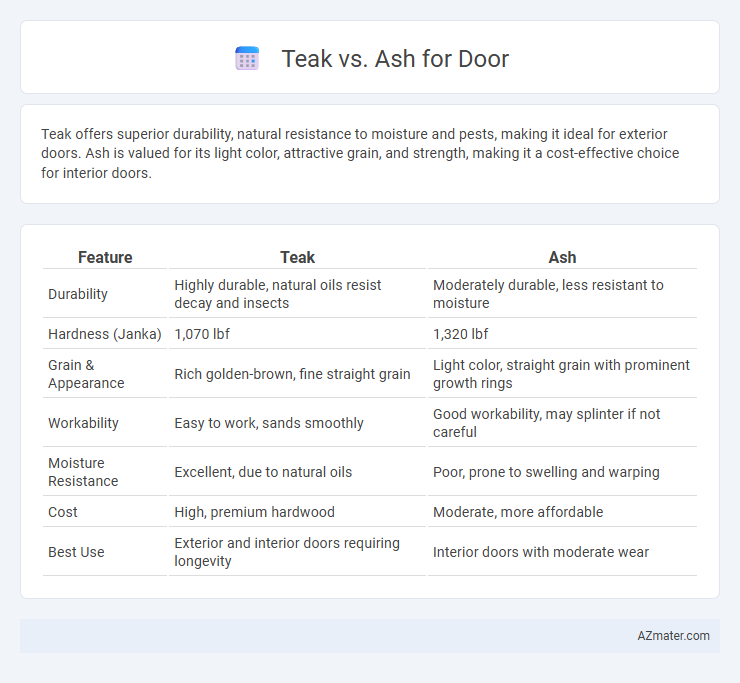Teak offers superior durability, natural resistance to moisture and pests, making it ideal for exterior doors. Ash is valued for its light color, attractive grain, and strength, making it a cost-effective choice for interior doors.
Table of Comparison
| Feature | Teak | Ash |
|---|---|---|
| Durability | Highly durable, natural oils resist decay and insects | Moderately durable, less resistant to moisture |
| Hardness (Janka) | 1,070 lbf | 1,320 lbf |
| Grain & Appearance | Rich golden-brown, fine straight grain | Light color, straight grain with prominent growth rings |
| Workability | Easy to work, sands smoothly | Good workability, may splinter if not careful |
| Moisture Resistance | Excellent, due to natural oils | Poor, prone to swelling and warping |
| Cost | High, premium hardwood | Moderate, more affordable |
| Best Use | Exterior and interior doors requiring longevity | Interior doors with moderate wear |
Introduction to Teak and Ash Wood
Teak wood, known for its durability, water resistance, and rich golden-brown color, is a popular choice for doors in both traditional and modern designs. Ash wood features a lighter color with a straight grain pattern and offers excellent strength and shock resistance, making it suitable for heavy-use areas. Both woods provide unique aesthetics and performance qualities, influencing the choice of material based on environmental conditions and design preferences.
Key Characteristics of Teak Wood
Teak wood is renowned for its exceptional durability, natural oils, and resistance to pests and moisture, making it an ideal choice for doors exposed to varying weather conditions. Its dense grain and rich golden-brown color enhance aesthetic appeal while offering superior strength compared to ash, which is lighter and less resistant to decay. Teak's stability and low maintenance requirements ensure long-lasting performance, especially in outdoor or high-humidity environments.
Key Characteristics of Ash Wood
Ash wood is known for its exceptional strength, flexibility, and striking light color with a pronounced grain pattern, making it a popular choice for durable and aesthetically appealing doors. It offers excellent shock resistance and stability, which helps maintain door integrity over time even under heavy use or varying environmental conditions. Compared to teak, ash is generally lighter and less oily, requiring protective finishes to enhance its natural resistance against moisture and decay.
Durability: Teak vs Ash Doors
Teak doors offer superior durability due to their natural oils and dense grain, making them highly resistant to moisture, decay, and insect damage. Ash doors, while strong and flexible with good shock resistance, generally require more maintenance to prevent wear in harsh or humid environments. The inherent weatherproof qualities of teak result in longer-lasting doors ideal for exterior use, whereas ash is often preferred for interior applications where durability needs are moderate.
Appearance and Aesthetics Comparison
Teak doors exhibit a rich golden-brown hue with natural oily grains that enhance durability and provide a luxurious, warm aesthetic, making them ideal for sophisticated interiors. Ash doors feature a lighter, creamy color with a pronounced, straight grain pattern that delivers a modern, clean, and airy appearance, perfect for contemporary designs. While teak offers a timeless, elegant look with deeper tones, ash emphasizes brightness and texture, allowing for versatile finishes and a fresh visual appeal.
Resistance to Moisture and Decay
Teak wood exhibits exceptional resistance to moisture and decay due to its high natural oil content and dense grain structure, making it ideal for door applications exposed to humid or wet environments. Ash, while strong and durable, is more porous and lacks the natural oils found in teak, making it less resistant to prolonged moisture exposure and more susceptible to decay over time. Choosing teak over ash for exterior doors ensures enhanced longevity and reduced maintenance in conditions with frequent moisture.
Maintenance Requirements
Teak doors require minimal maintenance due to their natural oils that resist moisture, insects, and decay, making them ideal for humid or outdoor environments. Ash doors, though sturdy and attractive, need regular sealing or finishing to prevent moisture damage and to maintain their appearance over time. Choosing teak reduces long-term upkeep costs, while ash demands consistent care to preserve durability and aesthetics.
Cost and Availability
Teak doors typically have a higher cost due to the wood's natural durability, resistance to pests, and limited availability, especially in regions where teak is not locally sourced. Ash wood offers a more budget-friendly option with greater availability, making it a popular choice for cost-conscious projects without sacrificing strength and aesthetic appeal. When selecting between teak and ash for doors, consider local market prices and supply, as teak's premium status and import costs often make it less accessible than ash.
Sustainability and Environmental Impact
Teak doors are highly durable and naturally resistant to pests, reducing the need for chemical treatments and extending their lifespan, which contributes to sustainability. Ash wood, sourced from fast-growing species, offers a renewable option with lower environmental costs due to quicker regeneration rates and less intensive harvesting processes. Both woods offer eco-friendly choices when sourced responsibly, but ash typically has a smaller carbon footprint and supports sustainable forestry practices more effectively than teak.
Which Wood is Best for Your Door?
Teak offers exceptional durability and natural resistance to moisture and pests, making it ideal for exterior doors exposed to harsh weather conditions. Ash is prized for its strength and attractive grain patterns, providing a cost-effective option with good shock resistance, suitable for interior doors or less exposed applications. Choosing between teak and ash depends on your door's exposure to elements and desired aesthetic, with teak favored for longevity and weatherproofing and ash for affordability and versatility.

Infographic: Teak vs Ash for Door
 azmater.com
azmater.com